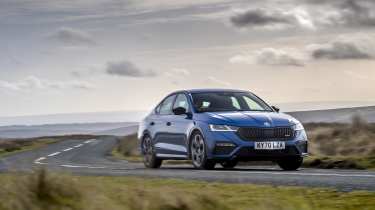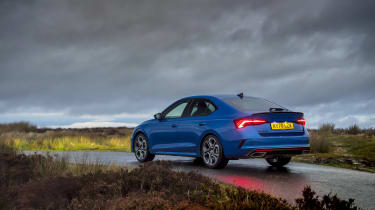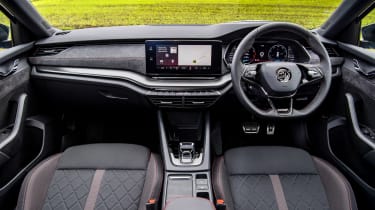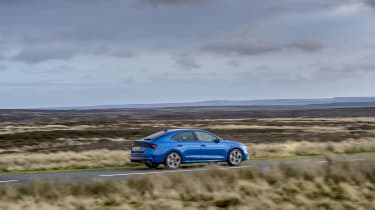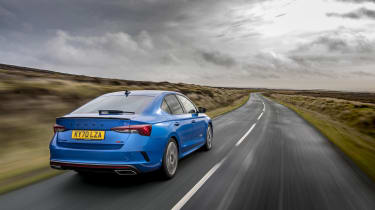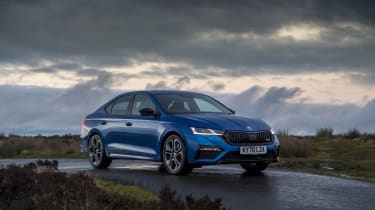Skoda Octavia vRS iV plug-in hybrid 2020 review – eco stealth
Skoda’s 242bhp plug-in hybrid Octavia vRS estate might further its appeal for some, but its inherited mass leaves little vRS left in what is an otherwise complete package
Skoda’s new Octavia has already impressed us in its vRS 245 TSI form, so the notion of one with an identical power figure, 30-odd miles of all-electric range, improved economy and (crucially) a reduced tax bill could only be a good thing right? Well, like Volkswagen and more recently Cupra, Skoda has now released its own performance plug-in with the vRS iV, so how does it adopt its new tech?
From the outset, not much has changed aesthetically between the standard petrol and plug-in vRS’s, with identical exterior and interior styling and standard equipment, save for sitting 15mm higher than other vRS models for some extra battery clearance and an extra fuel filler cap. But, does the added mass of the plug-in hybrid system still make for a desirable vRS?
Engine, transmission and 0-60 time
In keeping with the Volkswagen Group’s tireless homogeneity, the Octavia vRS iV’s powertrain is identical to those found in the Cupra Leon eHybrid and Golf GTE. That combination is of a 1.4-litre turbocharged petrol engine, mated to a specific six-speed dual-clutch transmission and an electric motor mounted between them. Drive to the front wheels comes from both electric motor and the petrol engine directly, the former fed from a 13kWh battery pack.
More reviews
In-depth reviews
Reviews
Combined equivalent figures are 242bhp, with a chunky 295lb ft of torque that send the vRS to 62mph in a somewhat leisurely 7.3sec, 0.6sec behind the pure petrol when fitted with a DSG. Top speed is 130mph, but of more importance here is its claimed 233.3mpg, and correspondingly tiny 27g/km CO2 rating – more on that later.
Technical highlights
The Octavia’s underlying structure is a familiar combination of Macpherson strut front and a multi-link rear suspension design. Passive dampers are standard, but adaptive units are available for an extra £925. As with all vRS variants the standard wheel size is 19-inches, and along with some subtly restrained aesthetic updates and set of brilliantly comfortable seats, also comes excellent matrix LED headlights, high-resolution infotainment interfaces and an overall aire of quality lacking in the closely related Audi A3 and VW Golf.
What’s it like to drive?
We’ve already been through a myriad of numbers, but perhaps the most striking is the kerb weight. At over 1700kg, the Octavia vRS iV estate is around 200kg heavier than the standard vRS DSG petrol, and its overriding driving impression on the road is dominated by it. Even with its spike of electrical assistance, the vRS iV feels laborious and lethargic in a way the pure I.C version just doesn’t.
That said, the blending of petrol and electrical power is nicely calibrated, with a smooth consistent surge of forward momentum only rarely interrupted by the transmission hunting around for the right gear. A slightly more challenging aspect is that as with most plug-in hybrids, the surge forward in momentum is most of the time irrelevant of the engine’s rise and fall of revs, creating a disconnect between your input and its response. There’s no obvious delay in the pedal, but your brain will quite often tell you otherwise, making it sometimes incongruous at normal speeds.
The regenerative brakes are similarly compromised, with Skoda obviously still working out how to blend two different braking systems into the one pedal input. It’s an issue that’s present across many plug-ins and BEVs, but one that in the sense of a vRS really knocks your confidence in the pedal, especially considering you’re stopping noticeably more mass. The adaptive regenerative braking system is also infuriating, automatically coming into effect as you approach a junction or roundabout. While this sounds like a helpful way of eeking out a few more miles from the battery pack, it’s too inconsistent in its activity, and so far as I could tell, is not able to be switched off or controlled manually.
When you actually use the meat of the power units though, the performance is just about acceptable, and on-par with the 197bhp diesel also available in the vRS range. Unlike the Cupra Leon eHybrid or VW GTE, the Skoda’s inherently softer ride quality makes it a relaxed everyday driver, and rather than feel like a hot hatchback with an economy car powertrain mounted in it, finds a finer balance as a less overtly sporty drive than it’s vRS badging might suggest.
Outright high-performance driving is not the Skoda’s forte though, grip from the front axle is limited, and when pushed it feels uncomfortable with every one of its many many kilograms. The powertrain struggles when at higher speeds too, as the blending of petrol and electrical assistance feels languid and not ideally calibrated to driving with any real vigor – as if the vRS can’t quite decide which of it’s two powertrains to use in contrast to leading with one and assisting with the other.
Finally, the on-paper economy figures might look impressive, but in everyday driving the reality will be quite different. Keep the batteries topped up and it’ll find between 20-25 miles before exhausting the 13kWh battery pack, but for longer distances in hybrid mode, it’ll reach 41-42mpg, tops, only a few more than would be reasonably expected from the 242bhp petrol, and no doubt down on the TDI diesel. The vRS iV, like all plug-ins, has a window of ideal usage, but if your journeys often fall out of this window benefits are likely to be limited to ones derived from the DVLA.
Price and rivals
There’s one more consideration to take into account with the vRS iV and that is its £35,020 price point (the estate is £36,220), making it an expensive way to save on some tax. While essentially identical under the skin, the Cupra Leon eHybrid is marginally less expensive at £34,495, but is also smaller inside.
Looking beyond plug-in hybrid alternatives and Volkswagen’s new Golf 8 GTE could be considered a rival, so too Ford’s diesel Focus ST. Looking higher up the spectrum, BMW’s basic 330e is a smidge over £40k, making it a more expensive proposition, but if you’re a company buyer or on a PCP, monthly’s are likely to be much closer, taking into account the BMW's impressive resale values.

